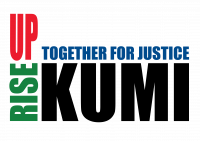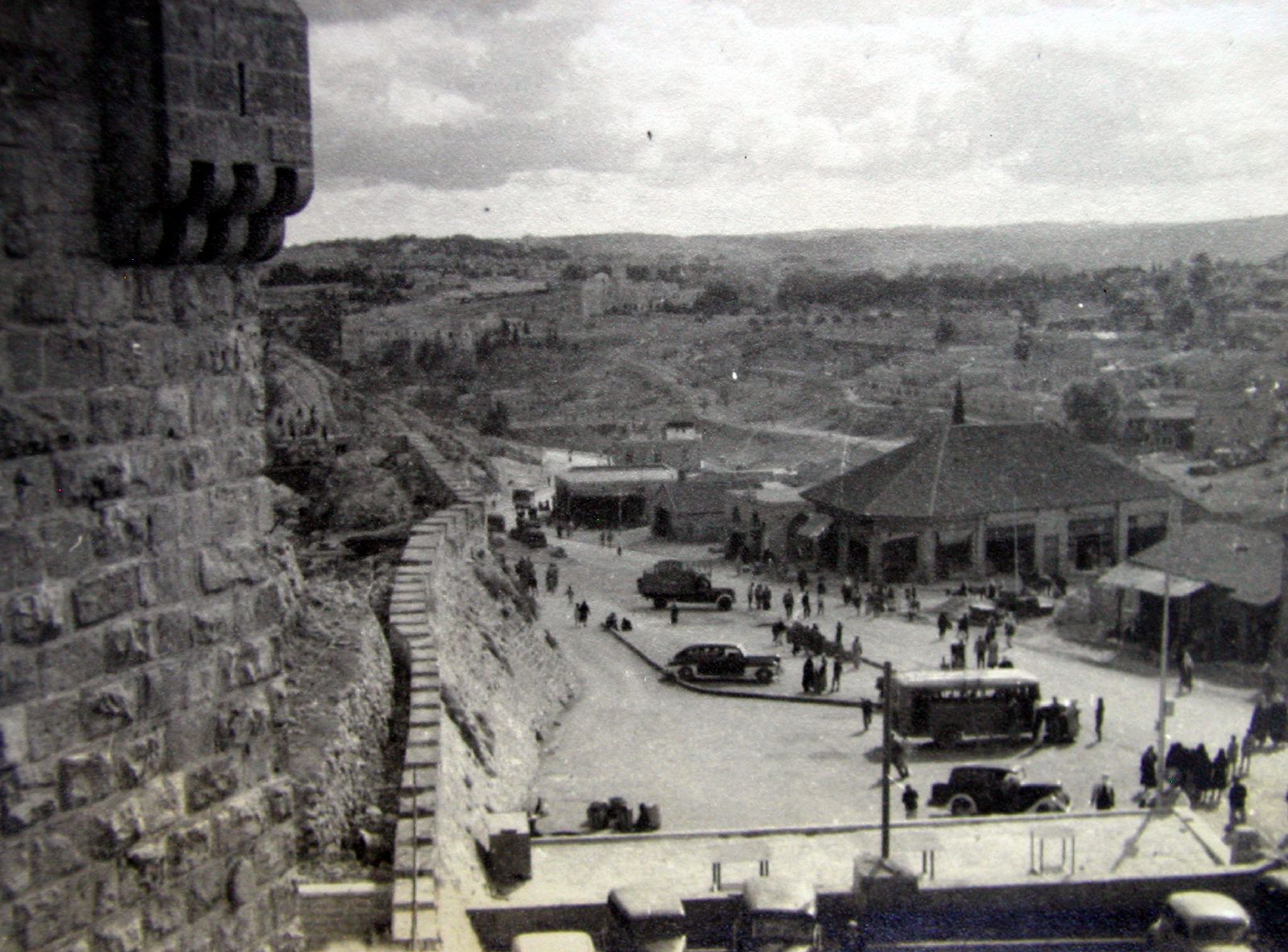Week 21: Preserving History and Culture
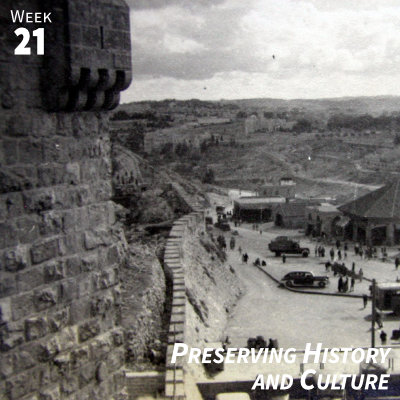
The United Nations celebrates May 21 as the World Day for Cultural Diversity for Dialogue and Development. The day was declared following UNESCO’s Universal Declaration on Cultural Diversity, a document that clearly sees cultural diversity and tolerance as key to developing the dialogue necessary to achieve peace and sustainable development around the world. However, Israel continues to build and plant over Palestinian history and culture while simultaneously erasing it from street signs, historical markers, and history books. Here’s what you need to know about efforts to preserve Palestinian history and culture so that together we may rise up.
Topic: Preserving History and Culture
In the summer of 2014, Israel launched Operation Protective Edge … During a brief lull in the bombing, photos emerged of a young Gazan girl in green dress sifting through the rubble of what remained of her home. She is looking for her books. When she finds them, she pulls them from the pile of shattered concrete and stacks them in her arms. The books are tattered and filthy, the covers dangling from their bindings. But when the girl walks away, her arms loaded with her books, she is smiling.
Marcelo di Cintio ends his book Song of the Caged Bird: Words as Resistance in Palestine with this story. It is an intentional metaphor for the entire Palestinian experience when it comes to Palestinian culture: from how that culture was attacked in the Nakba to how efforts are ongoing to preserve and build upon the cultural institutions that remain and rediscover the threads of culture temporarily lost in the Nakba.
The biggest cultural losses, of course, came with the depopulating, destruction, re-appropriation, and planting over of the more than 450 Palestinian villages emptied in the Nakba. Stones of Palestinian mosques, churches, meeting houses, and theaters were literally reused to build a Jewish and Israeli culture in their place.
As if the erasure of these villages and the expulsion and death of their residents wasn’t enough, there has been a concerted effort to erase Palestinian history and culture from the records and landscape. These processes are called Judaization (where Jewish communities, narratives, and institutions take the place of non-Jewish ones) and Israelization (where Israeli cultural or governmental systems and values replace Palestinian or Syrian ones).
Foremost of these processes is the forcing of demographic change to push Jewish and Israeli culture. Examples of this include the creation of Jewish settlements in historically Palestinian areas and the intentional efforts to counter Palestinian population growth in East Jerusalem, while simultaneously pushing Palestinians and their cultural institutions out through the revocation of residency rights (Week 7 and Week 30), demolishing Palestinian homes (Week 15), and providing government support to purchase Palestinian properties and homes (while discouraging the opposite).
Furthermore, there has been a concerted effort to erase Palestinian names from the maps, from the names of streets on up to villages, neighborhoods, geographic features, and historical sites. Nur Masalha in Palestine: A Four Thousand Year History describes part of the process
Following the mass ethnic cleaning of the Nakba … the cultural politics of naming was accelerated radically. State toponymic projects were now used as tools to ensure the effectiveness of the de-Arabization of Palestine. One of these tools consisted of the official Israeli road signs, which are often in Hebrew, Arabic and English. But both the Arabic and the English are transliterations of the new Hebrew place names—rather than reflecting the original Palestinian Arabic name. Of course the overwhelming majority of Israelis cannot read Arabic; this is partly to remind the indigenous Palestinians inside Israel of the need to internalize the new Hebrew place names or perhaps to seek the express approval of the vanishing Palestinian Arab making Arabs complicit in the de-Arabization of Palestine.
Masalha also describes how the maps were changed:
In the immediate post-Nakba period, Israeli archaeologists and members of the Israeli Exploration Society on the Governmental Names Committee concentrated their initial efforts on the creation of a new map for the newly occupied “Negev.” Commissioned to create Hebrew names for the newly occupied Palestinian landscape, throughout the documents produced by this committee were reported references to “foreign names.” The Israeli public was called upon “to uproot the foreign and existing names” and in their place “to master” the new Hebrew names. Most existing names were Arabic. Charged with the task of erasing hundreds of Arabic place names and creating Hebrew names in the Negev, the committee assigned Hebrew names to 561 different geographical features in the Negev—mountains, valleys, springs and waterholes—using the Bible as a resource.
History and archeology, and by extension tourism and pilgrimage, are also hotbeds of Judaization and Israelization, as, for example, documented in two reports from the Alternative Tourism Group. Government documents, museums, and school curriculums present “the history of Palestine in a form that responds to the aims of the Zionist project and at the same time ensuring that this new narrative creates a convincing historical depth for the project … The millennia-long history of Palestine is portrayed as though it started with the emergence of the Jewish religion when, in fact, Palestine and its people existed long before there was ever a Jewish presence.”
ATG also points to the theft of Palestinian archaeological artifacts, the destruction of historic buildings, the occupation and control of historical sites (such as Rachel’s Tomb), and archaeological digs that promote Israeli/Jewish interests while undermining Palestinian interests (such as excavations beneath the Haram Al Sharif in Jerusalem). And in studying the holdings of four Israeli museums they concluded that “Whether it is by ignoring Palestinian heritage or assimilating it into Israeli culture, the four museums in this study ignore the right of Palestine to its own history and identity (and) they cannot hide that a relevant part of their collections comes from the West Bank and the Gaza Strip.”
These names, artifacts, and narratives are then presented to tourists and pilgrims through guidebooks, local guides, and tours.
In addition to the archaeological treasures taken from Palestinian lands, there is the outright theft of Palestinian culture through the stealing of books, art, musical instruments and other instruments of culture. The documentary The Great Book Robbery explores how the Israeli National library collected thousands of books by looting the homes of Palestinians who had fled or been forced to leave their homes: “Between April 1948 and ‘49 librarians from the National Library ‘collected’ 30,000 books from abandoned Arab homes in western Jerusalem. It was a joint operation of the Hebrew University and the army … 60 years on they are still under “custodianship.” Nobody really thinks they will ever be returned.” This despite the fact that the library still has records of which households the books came from and 5,787 of them are kept in a special collection, labeled “AP” for “abandoned property.”
Rona Sela, a curator, expresses in the same documentary her support of the Palestinian position: “My own family’s visual history begins in 1948. My parents both survived the holocaust. All I have is two photos of my grandparents. Our albums begin when my parents met. There’s no past, no history. This void bothered me a lot personally. Now imagine such a void on a broader, national scale! Many Palestinian treasures were robbed, looted, or vanished during the 1948 war. Israeli archives contain a wealth of Palestinian materials.”
Furthermore, Palestinians have been cut off from the larger Arab cultural world (while, it should be noted, also being told that Palestinians do not exist, and that Palestinians are nothing but Arabs, by the same Zionists who have severed those connections). Prior to 1948, railways linked Haifa to Cairo to the south, and Beirut and Damascus to the north. These railways, just like railways across Europe and in other parts of the world, acted as cultural lifelines, connecting cultural centers to each other and freeing and encouraging the flow of ideas between them.
Not unrelated was the flight of academics, artists, and writers (what would now be called a brain drain) as, fleeing the Nakba like hundreds of thousands of other Palestinians, they settled as refugees around the world. The Great Book Robbery describes it thus: “Jerusalem, Jaffa, and Haifa. Before 1948, these are the major centers of Palestinian culture. Printing, publishing, theatres, and cinemas. The cultural elite—journalists, writers, thinkers—they all left in ‘48. The Palestinians who remained inside Israel became like orphans. Orphaned not just of political leaders but also of the cultural leadership that could nurture their existence as a collective.”
Facing the destruction of their villages, the theft of their books, the flight of the refugees and, of course, the death of thousands of artists and thinkers and the realities of day-to-day occupation, Palestinian culture was at its low point in the 1950s, while Palestinian history was being erased with every tree planted over a village and every document or book hidden or destroyed.
But then, the reversal. Artists and thinkers began to return. Authors found their voices and created a modern Palestinian literary movement. Films were created, makeshift theaters set up, literary journals founded, cultural centers built, memories of the Nakba were written down, so on and so forth. The effort to retain and nourish Palestinian culture and history planted seeds and then blossomed. These successes are too numerous to list all of them here, but include:
- Efforts to document Palestinian history both pre- and post-Nakba, from Walid Khalidi’s exhaustive All that Remains: The Palestinian Villages Occupied and Depopulated by Israel in 1948, (those with iOS devices can access much of this scholarship through the iNakba app) to the Atlas of Palestine (1917-1966), and the vast Palestine Oral History Archive.
- The founding of the Edward Said National Conservatory of Music in 1993, supporting thousands of students and the Palestine National Orchestra and Palestine Youth Orchestra.
- The organization and building of cultural organizations and centers across Palestine. Some of these include the Wojoud Museum (in a 650 year-old building in the Old City of Jerusalem), the Institute for Palestine studies, the Centre for Cultural Heritage Preservation, and the Riwaq Center for Architectural Conservation.
- The ambitious Palestine Museum, opened in 2017.
- The establishment of literary festivals, such as PalFest, and the Palestine Book Awards.
- The Cultural Heritage Project of The Palestine Institute for Biodiversity and Sustainability and the Palestine Museum of Natural History at Bethlehem University, focusing preserving both tangible and intangible aspects of Palestinian culture.
The United Nations has been clear both on how the international community values cultures and how it views Israel’s attempts to erase Palestinian culture. The Declaration on Cultural Heritage states, for example: “heritage in all its forms must be preserved, enhanced and handed on to future generations as a record of human experience and aspirations, so as to foster creativity in all its diversity and to inspire genuine dialogue among cultures.” While in regard to Israel’s policies towards Palestinian culture, the General Assembly passed a resolution in 2000 determining “that the decision of Israel to impose its laws, jurisdiction and administration on the Holy City of Jerusalem was illegal and, therefore, null and void.”
Contrary to the values of the United Nations, the laws and policies of Israel are firmly focused on erasing Palestinian culture, not preserving it so as to “inspire genuine dialogue between cultures.” The Nation-State Law of 2018 downgrades Arabic and makes it clear that Jewish culture is supreme within Israel. Thus, it is clear that the preservation and promotion of Palestinian culture and history must be an internal movement supported by the international community. These efforts must include opposing the Judaization of East Jerusalem and the West Bank, putting effort on Israeli museums and park organizations to tell Palestinian history and return Palestinian artifacts, and making sure that an accurate Palestinian history is taught in Israeli schools. Outside of these efforts, Palestinian artists, arts organizations, films, books, and other publications should enjoy worldwide publicity and success.
Kumi Now attempts to highlight many of these artists and authors through the Literature sections of these chapters and our other resources. But this week we will make a special effort to share the work of Palestinian artists and highlight the work of Palestinian cultural and historical organizations.
Story: “My Mother’s Piano” by Nora Kort
The story of the piano hurts me so much. And it brings back to life my mother’s memory.
I was invited to a conference in West Jerusalem on the status of the economy of Jerusalem in times of peace. And where was the venue? My family’s property, which is the Confederation House, which was the church, which was where the family lived on the second floor. And I’ve always longed to go there, because I was not born there. My father had died in 1993 and I was in mourning. The last words from his mouth, when I was visiting him with my friend Bill, were, “Please keep reminding her of the house.” At the time I intended to leave the country.
So I decided to go because it brought back the memory of my father, and I thought, “Hey dad, this is the chance to go and see the place.”
There were four panelists, and at the end I went up to the microphone and I introduced myself. I said, number one, that, “I’m a Palestinian and I’m here because of the subject, I’m a humanist, but before I say anything, can I ask how many of you here know the history of the place?” And there came the image of my father, saying “Hey, this is your chance.” I said, “If the stones could talk, the stones that are outside, they would tell you whose property this is. I come from the Korts, the remaining Korts in Jerusalem. This place is ours. This place had a church.” Oh my God, the cameras, the Israeli television, everyone came to the front and I stayed from 7 ‘o clock until midnight. And they were all writing and the Israeli television was filming …
Believe me, I forgot where I was and what I was saying. But I talked about the piano, and I was awakened from my trance by one of the women in the audience who said, “Oh, it’s the piano we have here. Bring your mother to play on it!” She said, “I’m the director of the center. I will give you my card. Bring your mother and she’s welcome to play on it.” And I said, “Ma’am, you’re wrong. I have the right to claim the piano.”
Over the years my mother saw so many pianos I wanted to get her and she rejected them. She said, “I want my own piano, the gift of my brother to me. My bother brought me up, he raised me up, I did not know my father. I was born after my father’s death and my brother brought me up as a father and a bother and he gave me my first gift, the piano, at the age of thirteen.” So my uncle was the one that brought up my mother and she kept dreaming about the piano.
Later on I took my mother to the place but the piano was gone. We went two weeks later. The woman was gone and the piano was gone. My mother’s description of the piano was that it had carvings on it. All that was there was a grand piano. So my mother’s piano was moved because they did not want any kind of leakage and they want no trace of whatever. It’s exactly like erasing the presence of the Palestinians from here. So they say this is the land of the Jews. And Judaism and Jews have been here since times immemorial and there are no other nations. It’s the same tactic, it’s the same strategy that they use but in different forms, but in different occasions, and for different purposes.
So my mother’s piano is gone. And when I told my mother her piano is gone she cried. She was like a little child. And ever since that time, until the time of her death, eleven years ago yesterday, she did not say anything, she didn’t want any piano, but she used to go and play a piano at her friend’s house because it brought back good memories of her brother singing along with her.
At the age of 83 she died. She knew all the tunes she had learned. It was so sad watching an old woman long for her piano. She used to say, “It’s mine. They took it away for no reason. Let me go get it!” I said, “Mother, how would they let you go get it? It’s not like they have open doors.”
So it’s very painful. What happened to my family is really like all the other Palestinians. It’s very painful, but to each and everyone there is some sort of uniqueness in the experience that they go through. I assure you that this will never be forgotten. Golda Meir, the first woman prime minister said, “The old will die; the young will forget.” But she was wrong. It’s hard. It’s very hard for people to forget. And I made this my own issue. That’s why I’m staying in the country. My immediate family is not here. They are in Europe and the United States. And I’m the only one from my immediate family staying, because of the history and the meaning.
I’ll be starting a foundation for the family. Because there’s a lot of culture and there’s a lot of heritage and I’m very proud to belong to my family because of their contributions to the community.
Nora Kort is founder of the Wujoud Cultural Centre & Museum in Jerusalem. She has also chaired the Arab Orthodox Society, which runs the St. Benedictos Medical Center and two income-generating projects for women (the Melia Art and Training Center and Bint al-Balad bakery). She continues to be a leader and community organizer, involved with many organizations over the years.
Kumi Action
We will write short profiles of different aspects of Palestine culture and history and share them, along with photos, with you via the newsletter and on the website. Take these profiles and post them, one per day, on social media, or print them out and post them someplace others can see them.
Include a link to this page of the Kumi Now website along with the hashtags #Palestinian, #KumiNow, and #Kumi21.

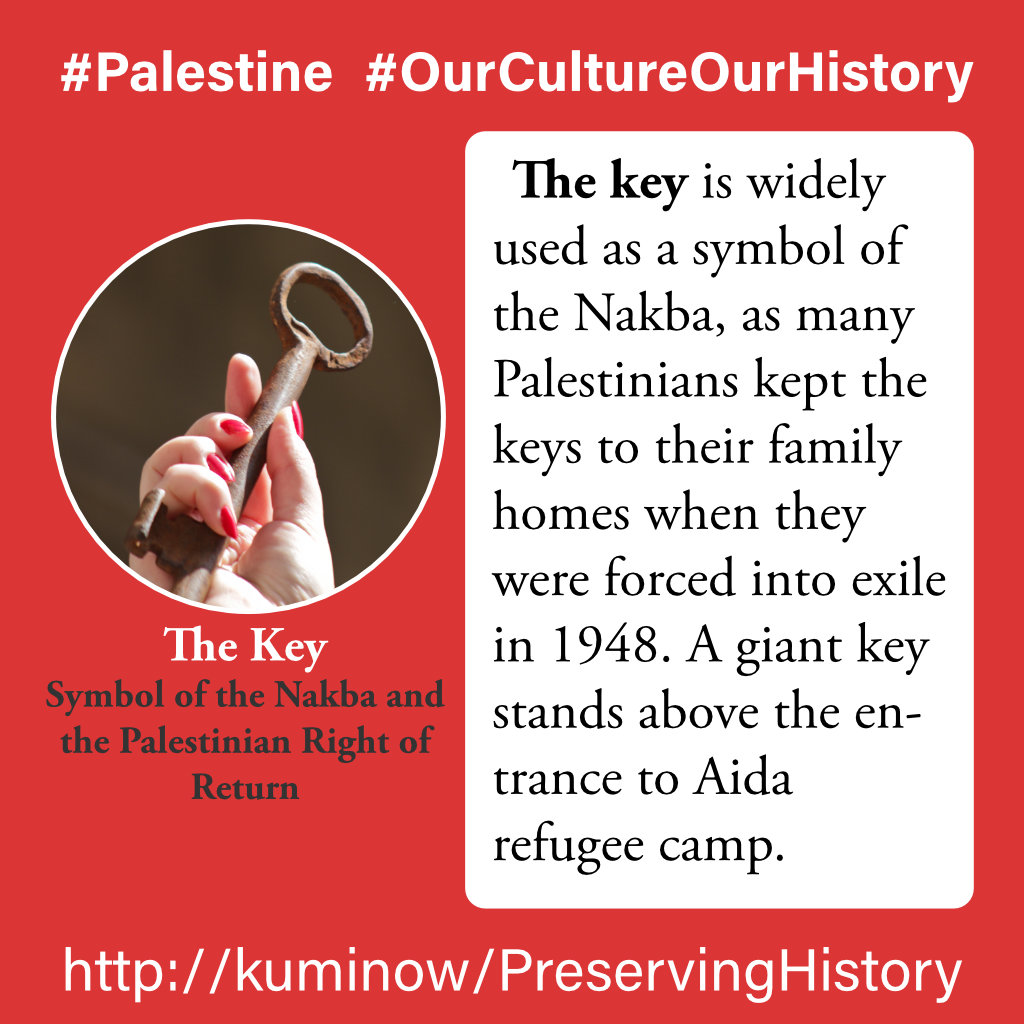
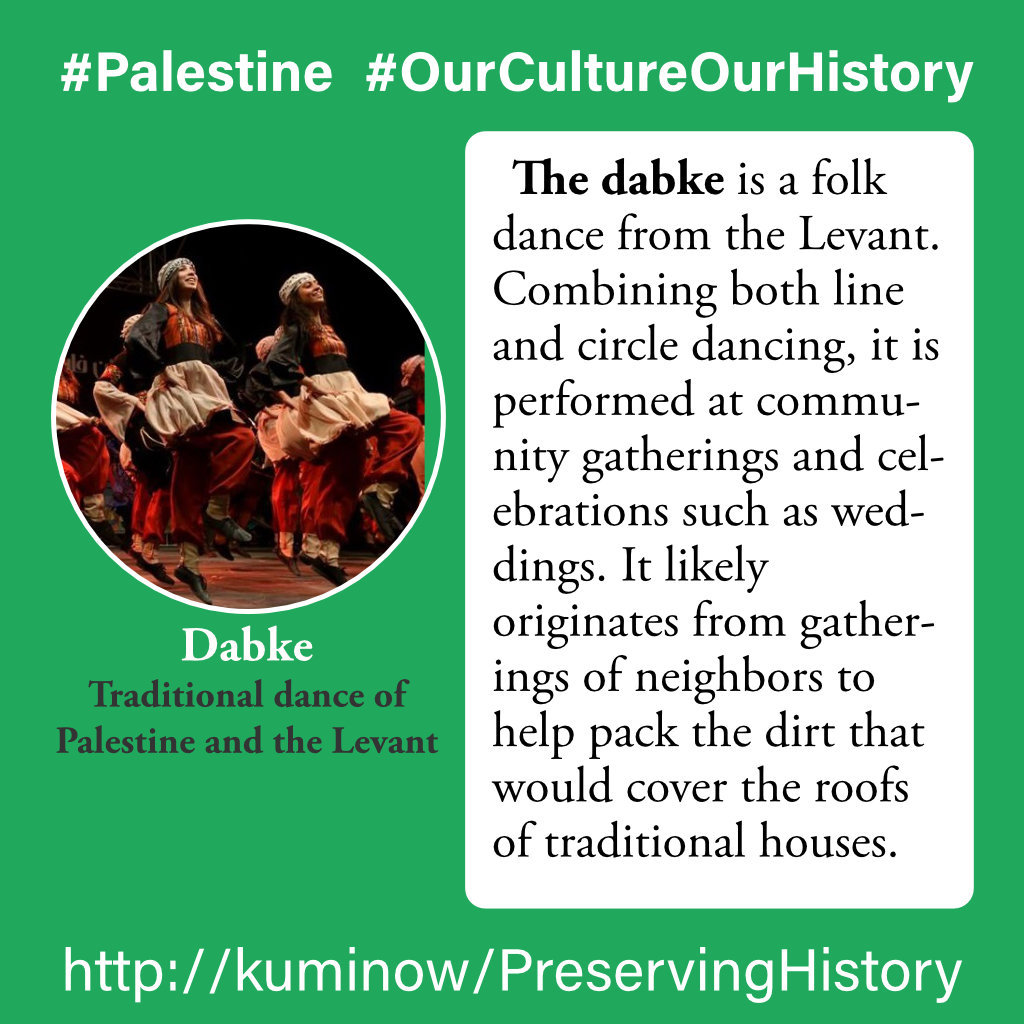
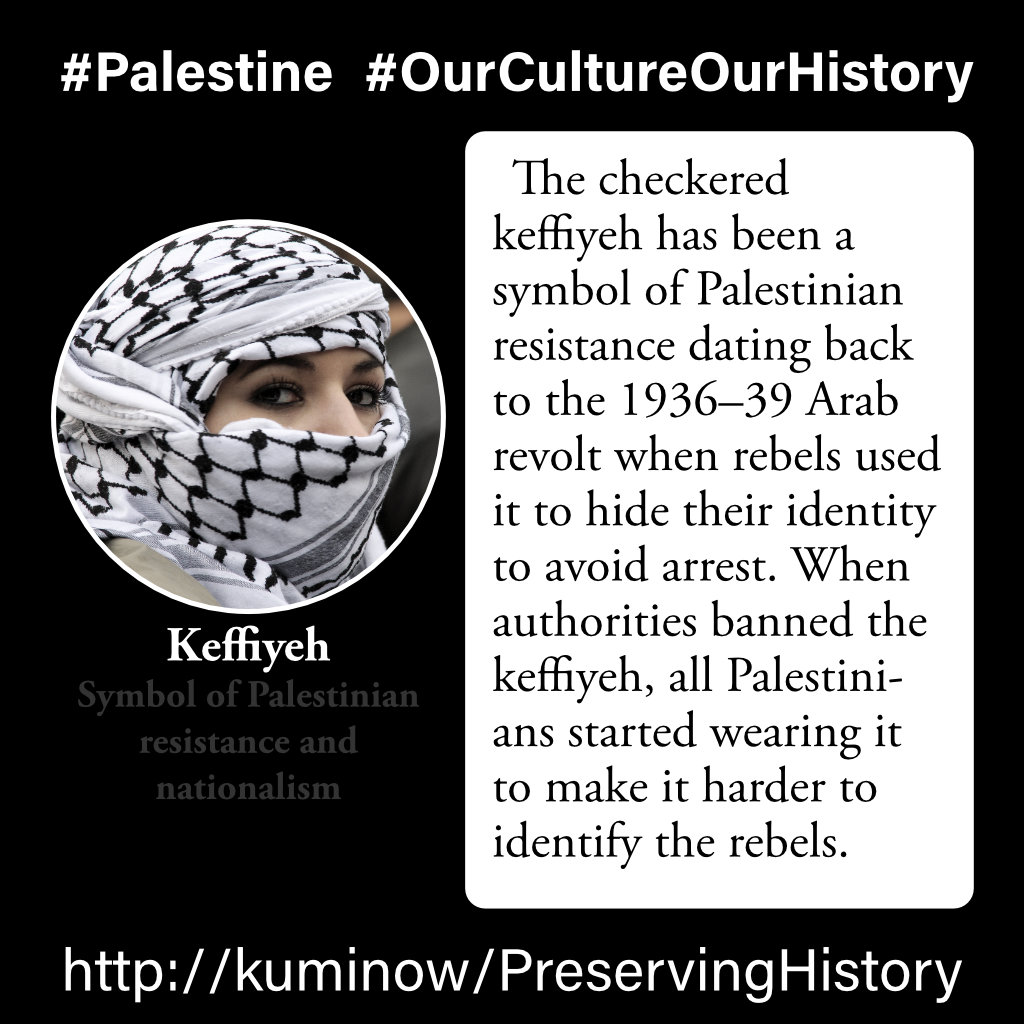
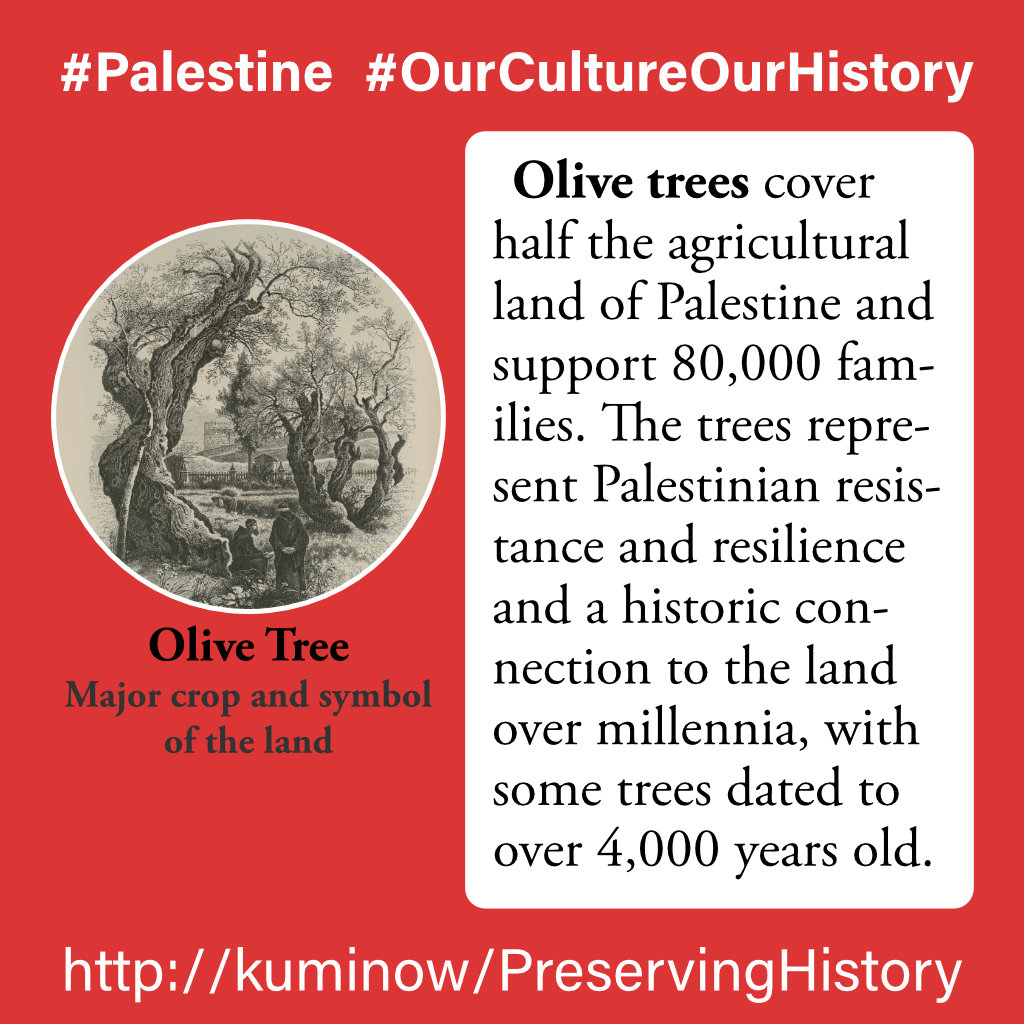
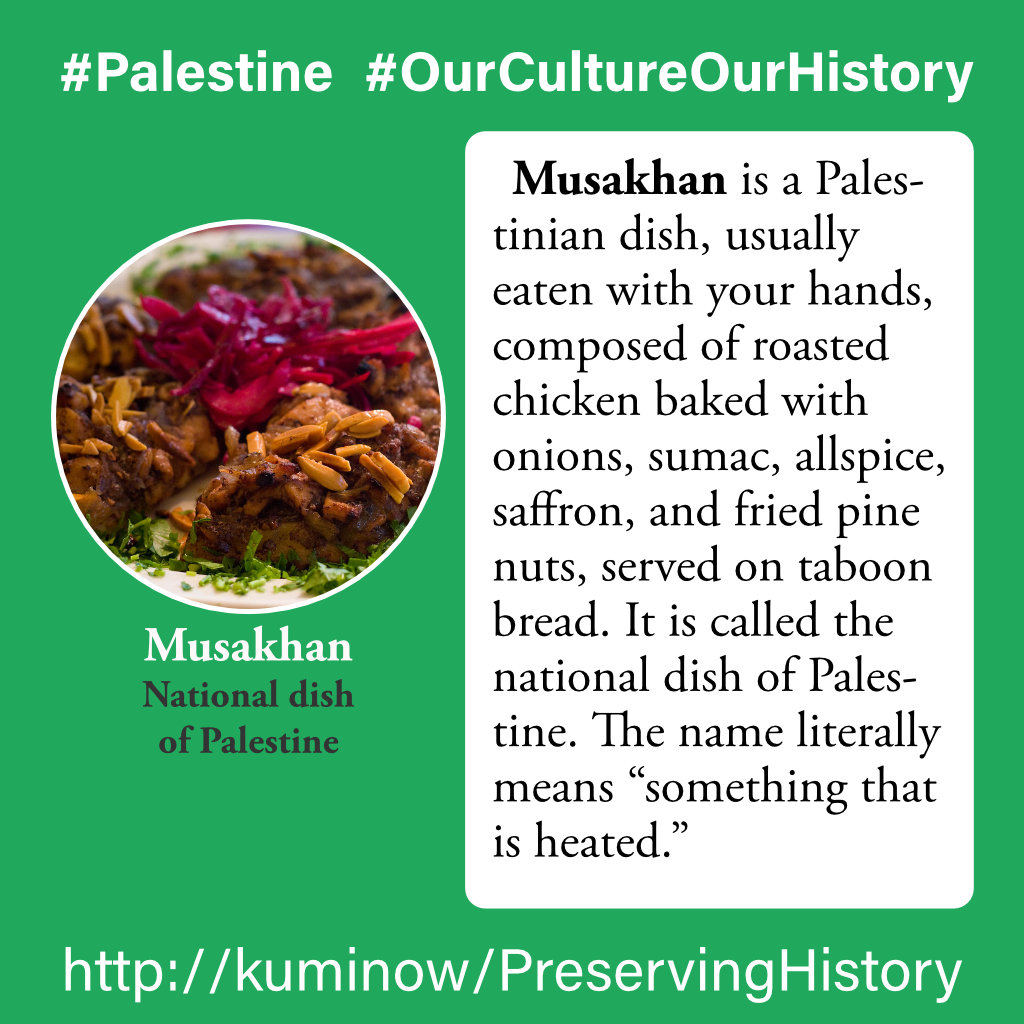
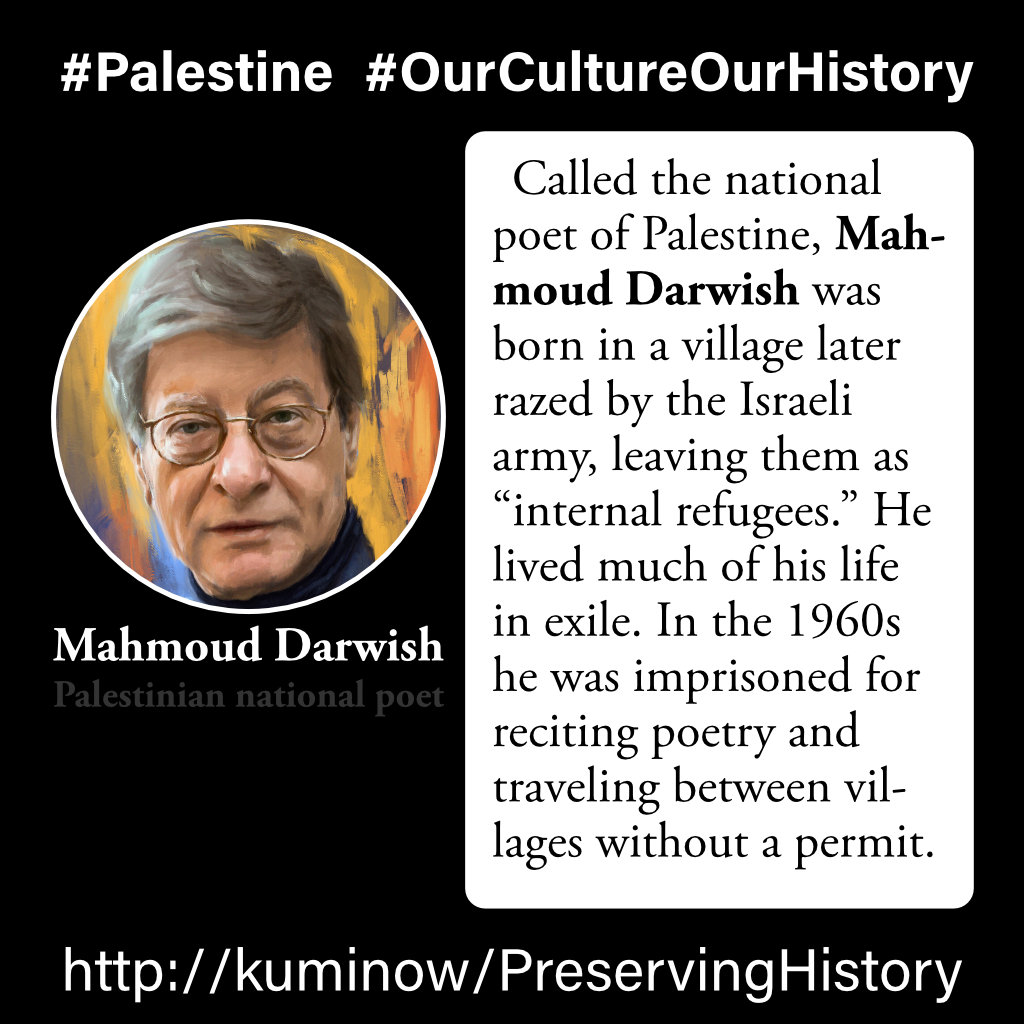
Literature: “We will not be erased: Why Palestinians are storming social media on April 30” by Susan Muaddi Darraj
In her essay “On the Meaning of Sumoud” for the Palestine Chronicle, Benay Blend defines sumud—which means “steadfastness” in Arabic—as “a mental state of resilience that translates into not accepting the status quo.”
In Palestine, the “status quo” is the steady attempt to erase Palestinian existence. When a Palestinian school is bulldozed, Palestinians instead hold classes in someone’s home. They replant trees and rebuild homes and entire villages that have been destroyed. Earlier this month, the Palestinian Bedouin village of Al-Araqib in the Naqab (Negev in Hebrew) was demolished for the 143rd time. No doubt it will be rebuilt, as it has been 142 times before. They will rebuild not because Palestinians have a tremendous capacity to endure such suffering. In fact, there is much despair among Palestinians—especially in Gaza—who reached a breaking point decades ago. No, they will rebuild because there is simply no other choice …
Culture matters because it is proof of Palestinian identity and existence. Preserving it and celebrating it is a form of cultural sumud …
We will not disappear. We will not be erased. Sumud.
From “We will not be erased: Why Palestinians are storming social media on April 30” by Susan Muaddi Darraj for +972 Mag. Published at https://972mag.com/palestinian-sumud-tatreez/141238/
Additional Resources
We have a YouTube playlist with videos about Palestinian history and culture.
Image Credits
Coming soon
